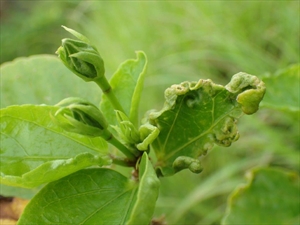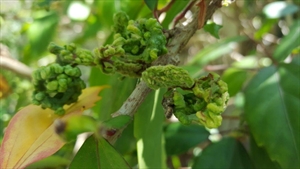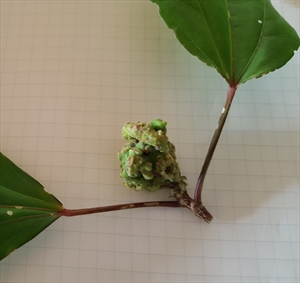Hibiscus mite, hibiscus erineum mite, hibiscus leaf-crumpling mite. The word 'erineum' is a botanical term meaning tuft of hairs. This describes the felt-like appearance of the galls.
Pacific Pests, Pathogens and Weeds - Online edition
Pacific Pests, Pathogens & Weeds
Hibiscus mite (266)
Eriophyes hibisci. Some accounts place the mite in the genus Aceria.
Unknown. It is present in the Caribbean and also recorded from Brazil. It is recorded from Australia, Fiji, and Tonga.
Chinese red hibiscus (Hibiscus rosa-sinensis), okra (Abelmoschus esculentus).
The mites attack the buds, and the plant reacts by forming rounded, bumpy, light green outgrowths a few mm across, at the leaf margins, on the leaf blades, petioles and stems (Photos 1-3). Often, the galls are formed in small groups (Photo 4), and in some parts of Fiji (Mamanuca Islands), symptoms are severe (Photos 5&6). The hardened plant growth is not affected.
Mites lay eggs and the 'worm-like' nymphs go through two stages before they are adult. They are too small to be seen with the unaided eye; a microscope is needed. The life cycle is complete in about 3 weeks.
The mites feed on the young leaves inside the buds and this stimulates the cells to form hairs so that the surface of the distorted, bumpy galls is felt-like. The hairs can be seen with a hand lens (x10) (Photo 5).
Spread of the mites is by the wind, or they are carried by birds or even insects.
The mites do not kill hibiscus plants, although they can slow their growth. The impact is cosmetic, affecting the appearance of the plant. Flowering can be prevented if the infestation is particularly severe (Photos 5&6).
Look for the distinctive galls on the leaves, petioles and stems.
NATURAL ENEMIES
The main natural enemies are predatory mites. These can be seen without the need for a microscope. They enter the buds where the hibiscus mites feed. If these fast-moving predatory mites are present, insecticides should not be used, as they will kill them.
CULTURAL CONTROL
Before planting & during growth:
- Ensure that cuttings taken for potted plants or hedges are only from plants that are free from symptoms. Carefully check plants from home or commercial nurseries before planting them out in the garden.
- Prune severely affected branches and burn the cuttings
RESISTANT VARIETIES
Trials in Hawaii have shown that there are differences between varieties in their tolerance to the hibiscus mite. Test different varieties present locally.
CHEMICAL CONTROL
Miticides are available for the control of broad mite, but these chemicals are seldom available in Pacific island countries. If there is no alternative but to use pesticides, then do the following:
- Prune the most mite-affected branches.
- Test sprays of natural products:
- Garlic is said to be effective against mites.
- Derris or sulphur.
- White oil (petroleum oil) (see Fact sheet no. 56).
- Abamectin is a miticide as well as insecticide; it is a relatively new product from a species of Streptomyces, a soil bacterium.
____________________
When using a pesticide, always wear protective clothing and follow the instructions on the product label, such as dosage, timing of application, and pre-harvest interval. Recommendations will vary with the crop and system of cultivation. Expert advice on the most appropriate pesticide to use should always be sought from local agricultural authorities.
AUTHOR Grahame Jackson
Information from Hara A, et al. (2001) Hibiscus erineum mite. Cooperative Extension Service, College of Tropical Agriculture & Human Resources, University of Hawaii at Manoa; and Green C, Gough N (2000) Hibiscus erinose mite. Centre for Amenity and Environmental Horticulture, Department of Primary Industries, Cleveland, Queensland. (http://www.hibiscusworld.com/pests/Erinose.htm). Photos 1-3 Richard Markham, ACIAR, Canberra. Photos 4-6 Frank Visser, Key Industries, New Zealand.
Produced with support from the Australian Centre for International Agricultural Research under project PC/2010/090: Strengthening integrated crop management research in the Pacific Islands in support of sustainable intensification of high-value crop production, implemented by the University of Queensland and the Secretariat of the Pacific Community.









